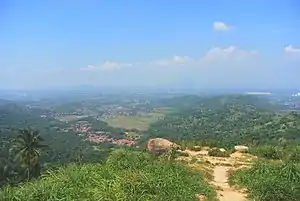Western Java rain forests
The Western Java rain forests ecoregion (World Wildlife Fund ID:IM0168) covers the lowland rain forests below 1,000 meters in elevation in the western half of the island of Java in Indonesia. There are a variety of forest types - evergreen, semi-evergreen, moist deciduous, and even some patches of freshwater swamp. The forests have degraded by conversion of the low areas to agriculture, and by logging. National parks protect some of the last remaining untouched rain forest. A number of endangered mammals are found in the ecoregion, including the Javan rhinoceros, the silvery gibbon, and the Javan surili.[1][2][3][4]
| Western Java rain forests | |
|---|---|
 Near the Port of Merak | |
 Ecoregion territory (in purple) | |
| Ecology | |
| Realm | Indomalayan |
| Biome | Tropical and subtropical moist broadleaf forests |
| Geography | |
| Area | 41,752 km2 (16,121 sq mi) |
| Country | Indonesia |
| Coordinates | 6.25°S 107.25°E |
Location and description
The ecoregion surrounds the interior volcanic mountain ridge of western Java, stretching 500 km in length but nowhere more than 60 km wide. Above 1,000 meters in elevation the ecoregion transitions into the Western Java montane rain forests ecoregion.[4]
Climate
The climate of the ecoregion is Tropical monsoon climate (Köppen climate classification (Am)). This climate is characterized by relatively even temperatures throughout the year (all months being greater than 18 °C (64 °F) average temperature), and a pronounced dry season. The driest month has less than 60 mm of precipitation, but more than (100-(average/25) mm. This climate is mid-way between a tropical rainforest and a tropical savannah.[5][6]
Flora and fauna
Almost 40% of the ecoregion is either under cultivation for agriculture or in built-urban areas. The remainder is 40% closed evergreen broadleaf forest, 14% open forest, and 6% other cover.[3] The forest is, however, highly degraded by logging. The evergreen forest's common plants include Artocarpus elasticus (a tree in the mulberry family), yellow mahogany (Dysoxylum parasiticum), langsat (Lansium domesticum), and Planchonia valida (a tree in the Lecythidaceae family). The areas of moist deciduous forest generally have 1,500 to 4,000 mm/year of precipitation. These forests feature palmyra palm (genus Borassus) and palm trees of genus Corypha.[4]
The ecoregion supports 101 species of mammals, five of which are endemic. Mammals of conservation interest include the critically endangered Javan rhinoceros (Rhinoceros sondaicus), the endangered silvery gibbon (Hylobates moloch), the endangered Javan surili (Presbytis comata), the vulnerable fishing cat (Prionailurus viverrinus), the endangered banteng (Bos javanicus), and the endangered Sunda slow loris (Nycticebus coucang).[4]
Protected areas
Only 2% of the ecoregion is officially protected.[3] These protected areas include:
References
- "Western Java rain forests". World Wildlife Federation. Retrieved March 21, 2020.
- "Map of Ecoregions 2017". Resolve, using WWF data. Retrieved September 14, 2019.
- "Western Java rain forests". Digital Observatory for Protected Areas. Retrieved August 1, 2020.
- "Western Java rain forests". The Encyclopedia of Earth. Retrieved August 28, 2020.
- Kottek, M., J. Grieser, C. Beck, B. Rudolf, and F. Rubel, 2006. "World Map of Koppen-Geiger Climate Classification Updated" (PDF). Gebrüder Borntraeger 2006. Retrieved September 14, 2019.CS1 maint: multiple names: authors list (link)
- "Dataset - Koppen climate classifications". World Bank. Retrieved September 14, 2019.
